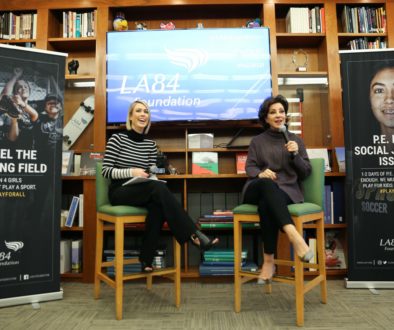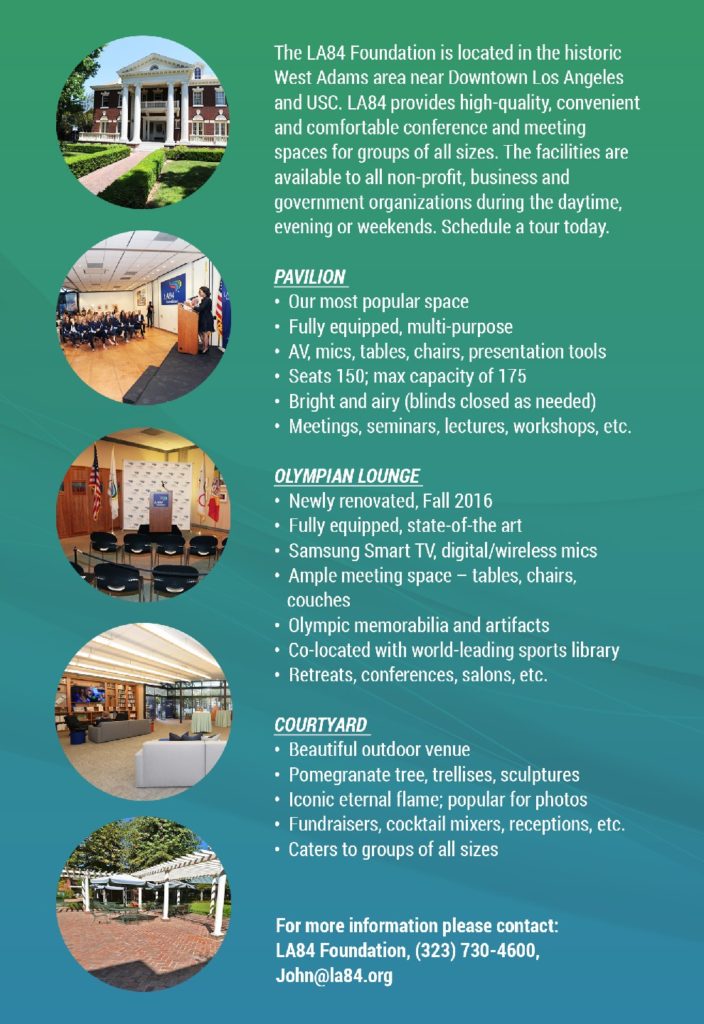SL Interview: Karen Ronney and Her Proud Parents Guide
Karen Ronney is the proud parent of three athletic girls. She’s also the author of a new book titled “Proud Parents’ Guide to Raising Athletic, Balanced, and Coordinated Kids” (Thomas Nelson; Amazon). The book aims to educate parents (as well as grandparents and educators) about how to take responsibility for creating coordinated, healthy and active children.
Ronney is a former competitive tennis player who now coaches youth tennis and other sports. She is one of 24 finalists for the Double-Goal Coach award from Positive Coaching Alliance. In the book, she uses her personal and coaching experiences and journalism background to craft this hands-on guide. The first half of the book details how children progress, biologically and neurologically, from birth to age six, and explains why it’s so important to engage children in physical fitness activities at an early age. Such intervention is vital, Ronney writes, if only to counter the dual trends of youth obesity and the elimination of physical education classes in many schools.
The second half of the book offers age-appropriate games for parents to use to help their youngsters develop motor skills and coordination. Ronney notes that the 200 easy-to-use activities, designed for the first six years of a child’s life, do not require expensive equipment. And, she emphasizes, even the hardest-working parents can carve ten minutes from their busy schedules to play with their children. This type of interaction works wonders, Ronney says, because exercise jumpstarts developmental skills and promotes a lifetime of good fitness habits.
“The ‘Proud Parents’ Guide’ is not about raising a super-athlete,” Ronney writes. “It’s about raising a healthy kid with good skills and coordination, one who considers physical activity an essential and enjoyable part of daily life.”
SportsLetter interviewed Ronney by telephone from her home in the San Diego area.
— David Davis
SportsLetter: Why did you decide to write this book?
Karen Ronney: The seed of this idea germinated for years. I’m an athlete and I wanted my kids to be athletes. When they were little, I went out to research books on how to help kids be coordinated, be athletic. I found that there was no one source: I had to get a book on how to teach football, how to teach soccer, how to teach baseball, how to teach a throwing motion.
As I got back into teaching tennis again, I noticed that many of my students weren’t able to hop with balance or throw a ball or track a ball coming at them or know how to put themselves in position in relation to a moving object. I started thinking, why don’t kids get it?
As recently as last week, at my high school tennis class, I brought jump rope and music. I handed a jump rope to an eighth-grader. He’s 13. He looked at me and said, “What am I supposed to do with this?” So that’s why I wrote the book. I wanted to help kids with physical exercise and coordination by giving their parents fun activities that they can do together.
SL: How are kids today different from those in the recent past, like when you were growing up?
KR: Growing up, I played baseball and football and sports all the time. I played sports on my street. Kids don’t do that today because our culture has changed. It’s considered not safe for kids to be out there playing in the streets or in the parks like we did, unattended and without parental supervision.
The second factor is, there are more two-parent working families today than previously. No one’s home to play with the kids. The kids are in daycare; they’re in after-school programs. They might get physical activities at these places, but they’re not doing the type of all-around sports and fitness activities that we did. So, there’s a big gap.
The third factor is, even when parents do have the time, they don’t know what to do. When I coached different sports — soccer and basketball and volleyball — I would give the parents individual assignments not based on the actual sport itself, but on the skill that their child didn’t have. I would say, “Your job is to play catch with your daughter.”
SL: You played tennis in college and on the professional circuit. How did your experiences as an athlete inform this book?
KR: I was really lucky. My dad was a physical education instructor at Rockefeller Center in New York City. His job was to teach adults how to play basketball, how to play badminton, whatever else was going on in the gym. We would go in the backyard and we would play catch. We would play tennis on the courts. He’d teach me and my brother and my sister whatever sport we wanted to learn. I was lucky to have a dad who didn’t think twice about teaching girls sports. Even today, dads don’t play catch with their daughters.
I wasn’t a supernatural gifted athlete. Things came to me, but with hard work. The beauty of that is, I know what it feels like to struggle to learn a skill. So, I wanted to translate that information to kids who might be in the same position.
SL: You’re also the mother of three children. How has that experience influenced your work?
KR: It was the inspiration for this book. Many of the games in the book came from what we did together. When my girls were one and two, we were playing balloon tennis, we were playing balloon soccer, we were playing with bubbles – catch ’em and slap ’em. We created an obstacle course in our home, where they jumped over cushions and went under chairs and climbed on top of the couches.
My girls grew up being very athletic, doing different sports and using multiple skills. I didn’t take them to the tennis courts until they were three, but by that time they could already make contact with the ball using really tiny rackets – like a ping-pong paddle.
Today, they all play sports. My oldest one is a junior in high school; she plays tennis, water polo and swims. My younger ones play tennis and soccer.
SL: How would you describe the philosophy of being a “Proud Parent”?
KR: Being a “Proud Parent” is about being an active participant in raising your child. It’s about getting involved with your kids when they’re babies, when they’re pre-schoolers and toddlers, so that they can develop fundamental coordination skills. Being alive and breathing doesn’t cut it. You have to give them purposeful activities to develop brain activity, to develop neurological skills. It’s amazing what the brain will do if it’s given that input when the kids are really young.
I’ll give you an example that I see whenever I get kids on the tennis court for the first time – and I don’t care what age they are. To teach the backhand to a right-hander, I teach a left-handed forehand. In other words, the left-handed forehand is the same as a two-hand backhand for a right-hander. I can call, with almost 100 percent accuracy, which kids have played piano because that’s a two-handed activity that involves neurological and coordination development. Doing different things at the same time. The only time I was wrong, it was a little boy who played the drums.
SL: Why should parents practice physical fitness and coordination exercises with their children?
KR: Kids will mirror what parents do. If parents are active, chances are that their kids will be. If parents get up and do a physical activity with their children ten minutes a day, the kids think: “Oh, mom and dad are playing catch; mom and dad are running, hopping, skipping and jumping with me. That must be the thing to do.” But if they see mom and dad sitting on the couch or sitting at the computer all day, they think, “Well, why do I have to move?”
I think that every parent is well intentioned. The dilemma is, parents don’t think they have the time. And, second, if they have the time, they have no idea what to do. They just need to realize that it only takes ten minutes to play a game that’s totally engaging and fun for their children and that also helps their kids develop coordination skills. And, it only takes ten minutes because, honestly, that’s the most that kids can focus anyway.
SL: How do you develop coordination with children?
KR: It starts with the brain. Even when babies are little enough to not know what’s going on, they’re developing eye-hand coordination and eye-foot coordination. They’re developing eye-tracking skills that, later, relates to spatial ability – being able to put themselves in position to catch a ball or throw a ball or hit a ball. They’re developing torso strength and head strength.
It’s interesting because, doing the research for this book, I came across another reason why kids are not as fit today. Nowadays, because of the incidences of SIDS [Sudden Infant Death Syndrome], many pediatricians tell parents, “Back to sleep; tummy to play.” That’s so that nothing blocks the child’s passageway for breathing. But because kids are spending less time on their tummies, they’re not developing their torso strength, their eye-hand coordination, head and neck strength. They’re lying on their backs 90 percent of the day unless parents make a concerted effort to put them on their tummies.
Parents need to be aware of this because physical therapists and occupational therapists are having more kids come in with weak necks and shoulders and torsos. That translates into another delay of coordination activity. It’s like a domino effect.
SL: Why is it so important for parents to work with their children at an early age?
KR: When we’re born, we have all the brain cells that we’ll need for the rest of our lives. But it’s the neurological pathways, or connections, from brain cell to brain cell that really count. The more activities you do with your kids, the more you help them to develop the connections between brain cells. If you have that, you’ll never lose it. But if you never develop it, you’ll never have it. So, early is good.
SL: Many of the exercises in the book focus on eye-hand coordination. Why is it so important to develop this among youth?
KR: Because everything starts with the eyes. What you see is what you do. In tennis, if your eyes can track the speed of a ball and translate that information to your brain, your brain will be able to tell your body, “You need to run four feet over there to get to the ball.” It’s the same thing with soccer. Kids with good coordination know how and where to put their body in relation to the ball coming at them. Fitness and footwork: if they get that early, then they can play anything.
SL: Are there certain eye-hand experiences that most benefit children’s overall coordination and intelligence?
KR: One thing is the ability, if the child is right-handed, to reach across to the left side of his or her body and grab an object on the other side. Vice versa for left-handers. It’s called mid-line crossing.
When that movement happens, it means the two halves of the brain are working together. If the two halves of the brain are talking to each other, kids can skip and run and hop and catch balls, and they have really good spatial skills. There’s balance, so the whole body works as a unit. If the two halves of the brain are not communicating effectively, then kids look awkward. They’re afraid of objects coming at them.
This is not just for sports. It goes into everything a kid does. It’s for music, and it’s for art.
SL: You write about “sidedness” in the book. What does “sidedness” mean?
KR: The research tells us that our hands, our feet, our eyes and our ears are either left or right dominant. If you’re dominant with one side — right-hand, right-foot, right-eye, right-ear – it means that you’re laterally balanced. Which is a good thing. A lot of people – myself included, as I’ve learned – are mixed dominant. That could mean that you’re a right-handed thrower who’s a left-footed kicker.
This also comes into play with vision. If your dominant eye is not the same as your dominant hand, there’s a delay in your ability to judge distances and the space between an object and you. I see this when I teach tennis sometimes, when kids trying to hit the ball are constantly jammed up because the ball comes too close to their bodies. When I test those kids, 90 percent of the time they’re mixed dominant. Their dominant eye is not giving the brain accurate information. So, I have to teach them how to adjust to that.
SL: Why is it that about 90 percent of kids are right-handed and ten percent left-handed?
KR: It’s purely genetics. Ten percent of the world is left-handed; three percent of all athletes are left-handed.
SL: How does play, which you describe in the book as the “foundation for a happy childhood,” aid in the learning development of children?
KR: It has to be all about play because play is fun. We learn through play. If kids have games and activities that are play-based, it makes learning so much fun that they don’t even know that they’re learning. When it’s skill- or drill-based, it doesn’t work. I call it “drill and kill.”
As kids get older, they want to win and compete. Still, if you add a cooperative element among these older kids, particularly for teens, you can get them working harder than you could ever imagine.
SL: In your experience, what are the major missteps that parents make regarding their child’s physical fitness?
KR: I think parents don’t understand the definition of fitness. They don’t know how to get their kids to be fit. Parents think fitness is signing their kid up for rec soccer. What they should be doing is playing games that get their kids moving – whether it’s hopping, or running or skipping or shooting baskets. That’s what it takes, no more than that.
SL: What other mistakes do parents make?
KR: Number one is, signing their kid up for a rec class and saying, “Be my child’s baby-sitter, and I’ll be back in an hour.” That’s the uninvolved parent.
The other end of the spectrum is the crazies. You’ve seen them in hockey, in Little League, in all sports. These are parents who are determined that their child is the next Tiger Woods or Roger Federer. They’re serious hard-core pushers whose kids endure hours and hours of training. These are the scary parents because they’re going to burn their kids out and freak them out. The kids will never want to play the sport again.
The majority of kids want to play for an hour or two, have fun and go home. The trick is, make it fun and be done before the child is done. Parents shouldn’t be the one saying, “C’mon, let’s keep playing.” They should end the session with, “Okay, we’re done, we’ll come back another day.” If you leave them asking for more, they’ll come back.
SL: How does that relate to the issue of specialization in sports?
KR: Specialization is a little bit scary and a little bit necessary. Today, the level of skill in kids is about 100 percent higher than it was even five years ago. The girls that I see playing junior tennis today, at 16, are as good as anyone I played against in college. Why are they so much better? Because they’re playing younger and they’re specializing sooner.
If you’re not playing your sport, and only your sport, fulltime by age 10, you’re not going to make it at the high school or college level. That’s a very sad comment.
So, sports specialization is a necessary evil. But I’ll also say this: if you can provide your child with another sports option – like doing swimming and soccer – generally long-term they’ll be happier.
SL: How should parents approach this, balance-wise, if their child has the potential to play sports at a high level?
KR: I’m dealing with that in my home right now, with my daughters. I purposefully built in two months off this winter. We didn’t play any tennis — we didn’t play tournaments, we didn’t practice — for November and December. Conceivably, they could play tennis year-round, just like kids can now play baseball or soccer or volleyball twelve months a year. But having time off is essential. It has saved their bodies, and it’s saved their desire to play. Now, they’re itching to get back to it.
That’s my advice to parents: build in time off. It’s okay. No kid should be playing any one sport year-round. You’ll prevent injuries and preserve their love of the game.
Also, children shouldn’t be doing a single sport every single day. Maximum benefits are three to four times a week. If they’re going five to seven times a week, they will burn out. So, if they play baseball, let them play basketball also.
SL: You presented more than 200 games in the book, with each designed to last from two minutes to ten minutes. Why such a short time frame and how did you go about choosing the games?
KR: The time frame is based on my observation of kids’ attention spans. Less is more: they get an excellent workout, they have fun, and they’re on the road to having great fitness habits.
The point of all the games is that they’re based on activities you can do at home or in your backyard. The big myth to overcome in parents’ mind is, “Oh, I have to take the kids and go to the park or the playground.” No, you don’t. You don’t have to go anywhere.
Also, the games I chose usually involve common household items. That eliminates the cost of buying expensive equipment. Parents don’t have to buy a soccer goal. Guess what? We turned a laundry basket on its side, and there’s our goal.
The games are all about parent-child involvement, and they’re convenient, they’re easy, they’re fun, and they’re cost-effective. In ten minutes, you can create an amazing athlete by the time your child is seven. The side benefit is that I created so many personal and family memories playing these crazy, silly games with my kids.




